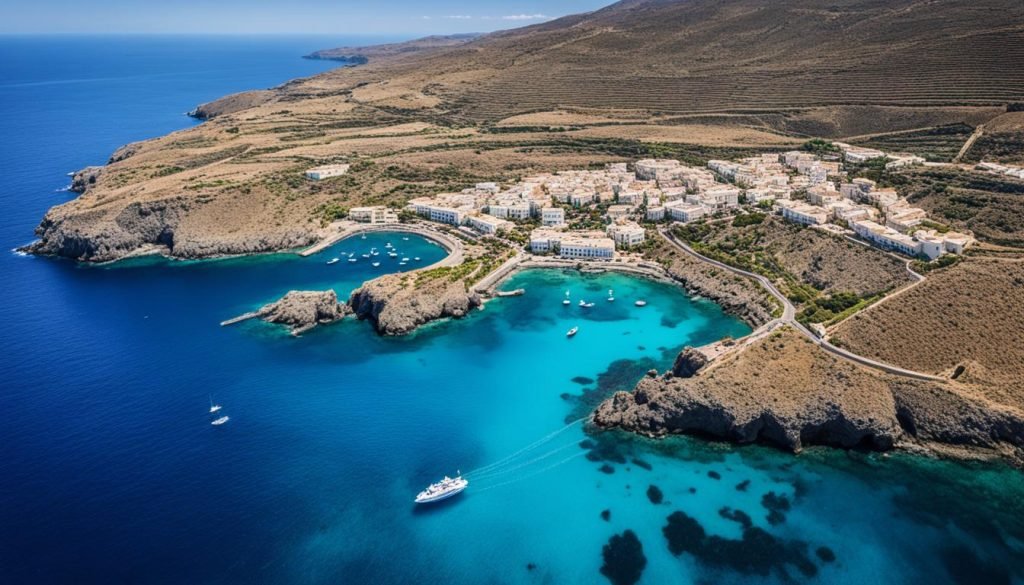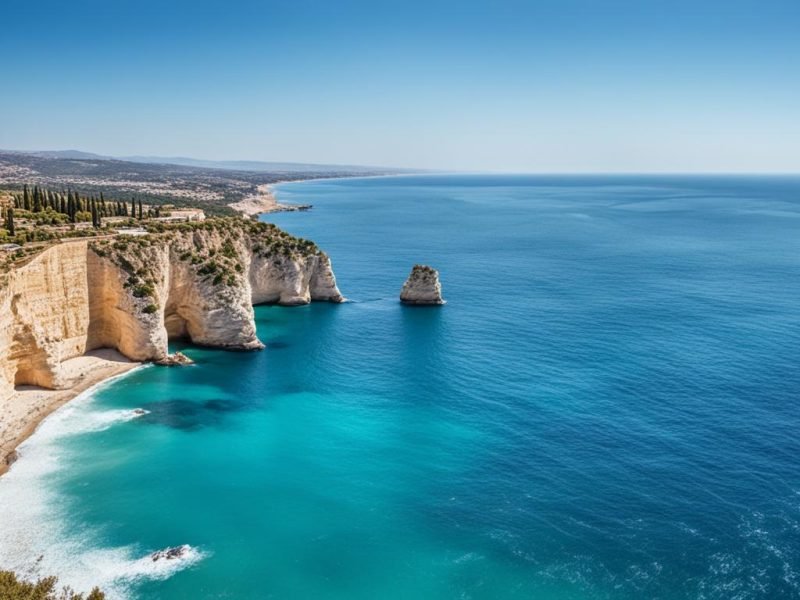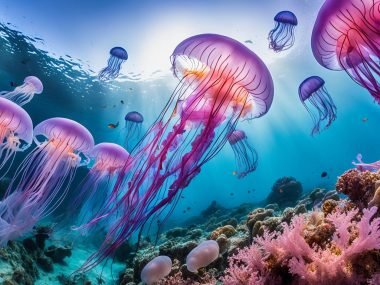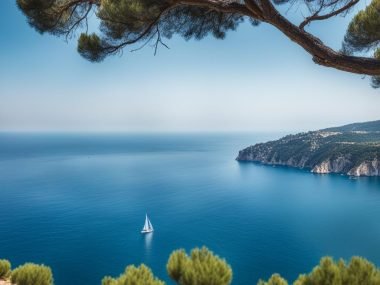Imagine gazing across a serene expanse of blue, where the waters of the Mediterranean Sea stretch away towards the horizon. You raise your eyes, searching for a sight that seems almost mythological. The question arises: does the geographical reality permit a line of sight from Tunisia’s northernmost point to Italy’s southern reaches? This geographical query tantalizes those who dream of beholding one European country from the coast of another African nation.
Key Takeaways
- The Mediterranean Sea serves as a scenic backdrop for an exploration into the visual connectivity between Italy and Tunisia.
- Geographical realities, including distance and the Earth’s curvature, influence the line of sight across international waters.
- Understanding the geographical span of the Mediterranean is key to addressing the question of intercontinental visibility.
- Cultural and historical connections further enrich the intrigue surrounding the visual proximity of these two nations.
- The Mediterranean Sea, while a natural barrier, also represents a link between diverse cultures and civilizations.
Exploring the Geographical Proximity of Italy and Tunisia
The Strait of Sicily, a span of the Mediterranean Sea, articulates the geography that lies between Italy and Tunisia. This substantial stretch of water not only separates the landmasses but also presents a topic of interest regarding the visible distance connecting these two countries. While the visible gap seems to solidify the distinction, the presence of the mid-Mediterranean island of Pantelleria provides a unique perspective to the otherwise intangible link.
The Strait of Sicily as a Natural Separator
Acting as the geographical referee between the southern tip of Italy and the northern coast of Tunisia, the Strait of Sicily sets itself as a natural barrier. The distance that spans approximately 155 kilometers (96 miles) indicates how two nations, so close within the basin of the Mediterranean, can also be distant enough to limit the general view from one shore to another. Despite this, the human endeavor to bridge this natural gap surfaces in talks of the Strait of Sicily Tunnel, which could possibly shorten the perceived distance through innovative engineering.
Pantelleria: A Visual Bridge Between Continents
Sitting just 37 miles off the coast of Tunisia and belonging to Italy, Pantelleria takes on the role of a visual intermediary, a rugged terrain offering an overarching view amidst the maritime expanse. The topography of the island, marked by precipitous peaks and tiered agriculture, sketches a vivid picture that blurs the boundaries set by the Strait of Sicily. It becomes a geographical spectacle that both delineates and connects the continents.

In light of this, the geography within the Mediterranean Sea emerges not only as a subject of environmental science but also as a canvas for cultural and economic narratives shared between Italy and Tunisia. It evokes a certain intrigue concerning the proximity and the capacity for these landmasses to interact visually and physically—a conversation that unfolds in the landscapes and the depths of the waters in between.
| Geographical Feature | Location | Distance from Coast | Relevance |
|---|---|---|---|
| Strait of Sicily | Between Italy and Tunisia | Approx. 155 km (96 miles) | Natural separator influencing visual and physical connection |
| Pantelleria | Southwest of Sicily, Italy | Approx. 37 miles from Tunisia | Offers potential visual interaction between Italy and Tunisia |
While the straight-line distance creates a default separation, the geography of the region, graced with islands like Pantelleria and potential feats of engineering, suggests a redefined closeness—reshaping the conventional viewpoint regarding the Strait of Sicily and raising questions about the links between Italy and Tunisia beyond the mere concept of distance.
Travel and Connectivity: Ferries Linking Italian and Tunisian Shores
The Strait of Sicily, a crucial navigational channel between Sicily and Tunisia, not only separates the two lands geographically but also connects them culturally and economically through various maritime routes. Ferries are one of the main vessels that track the waters of this busy strait, facilitating travel and trade between the Italian cities of Palermo, Trapani, Civitavecchia and the Tunisian capital, Tunis.
Ferry Routes and Their Role in Cross-Strait Travel
Key maritime routes have been established to cater to the demand for travel and commerce between the two Mediterranean neighbors. The Palermo–Tunis route, offering three round trips per week, the Trapani–Tunis route, ensuring a weekly connection, and the Civitavecchia–Tunis line, with its two voyages per week, represent the vital links that enhance mutual accessibility. These ferries not only provide a passage for tourists and locals alike but also carry the promise of economic cooperation and cultural exchange.
| Route | Departures/Week | Departure City (Sicily) | Destination City (Tunisia) |
|---|---|---|---|
| Palermo–Tunis | 3 | Palermo | Tunis |
| Trapani–Tunis | 1 | Trapani | Tunis |
| Civitavecchia–Tunis | 2 | Civitavecchia | Tunis |
Potential Impact of the Sicily-Tunisia Tunnel Project
Looking toward the horizon of trans-Mediterranean infrastructure, the anticipated Strait of Sicily Tunnel megaproject could herald a significant shift in the dynamics of travel and trade between Sicily and Tunisia. This bold initiative aims to create a more permanent and efficient link between the two, potentially transforming the current dependency on ferries into a high-speed, integrated transport network. Such an infrastructure undertaking would not only stitch the geographical proximity into tangible connectivity but also stands to become an economic catalyst for the regions it serves.
The vision of a direct tunnel promises to accelerate movement and deepen ties, adding a layer of resilience and synergy to the existing ferry-based maritime routes. With this project, Sicily and Tunisia are poised to redefine their historical relationship, underlined by a modern engineering feat that bridges the robust waters of the Mediterranean Sea.
Can You See Italy From Tunisia?
When looking out over the Mediterranean Sea, the question arises—Can You See Italy From Tunisia? This inquiry ties into a deep-rooted human interest in the concept of distance and our curiosity about the world’s geographical tapestry. Within this exploration, there’s a constant interplay between the measurable distance separating two points, and the perspective required to perceive one from the other.
The geographical space that swathes between Italy and Tunisia is both immense and inviting, prompting observers to seek a viewpoint from which the Italian coast could seemingly be just over the horizon. However, the Earth’s curvature imposes a natural limit on our line of sight. Therefore, even with ideal weather conditions, discerning one coastline from the other falls beyond simple observation. It is a substantial spatial relationship shaped by natural forces and navigated through human ingenuity and technology.

To address the core of the Can You See Italy From Tunisia question, it’s essential we invoke a scientific perspective. While the prospect is alluring, the key to understanding this possibility is through considering elements such as elevation, atmospheric refraction, and the planet’s topographical features.
From a purely theoretical standpoint, ignoring Earth’s physical obstacles, the view one seeks might be a tangible capture; but various intervening factors steer this into the realms of rhetorical musing more than practical reality.
Some might argue that high vantage points or the use of advanced optics could nudge the boundaries of visibility. Yet, these methods still contend with geographical realities and the immensity of the distance that stands resolutely between the edges of the two nations.
In sum, the quest to resolve the enigma—”Can You See Italy from Tunisia”—dives into a complex synthesis of observation, scientific understanding, and the inherent constraints of the human experience set against the canvas of our terrestrial home.
Unveiling Pantelleria: Italy’s A-List Destination Near Tunisian Waters
Nestled in the heart of the Mediterranean, Pantelleria strikes a delicate balance between its rugged natural beauty and its reputation as an A-list destination. The island’s proximity to Tunisia, just a stone’s throw away from the African coast, enhances its allure, solidifying its status as a glamorous getaway within the Mediterranean landscape. Celebrities and well-heeled travelers are drawn to Pantelleria’s striking volcanic terrain, its hot springs, and the secluded coves that offer a sense of exclusivity. The island embodies a quiet magnetism that captures the essence of the Mediterranean culture while showcasing the depths of Pantelleria history.
Pantelleria’s Unique Geography and Celebrity Appeal
The dramatic cliffs and the azure waters of Pantelleria create an atmosphere of seclusion and luxury, attracting high-profile individuals seeking escape from the limelight. The island, known for its capers and sweet dessert wines, offers an idyllic retreat for stars like Giorgio Armani who have found solace in its Mediterranean beauty. Its position between Italy and the African coast highlights not only a stunning Italian-Tunisian connection but also a synergy of natural elements that make it a picturesque haven of tranquility.
The Rich History and Blend of Cultures on Pantelleria
The narrative of Pantelleria is a chronicle of conquests and cross-cultural influence, with traces of Phoenician, Ancient Roman, and Arab presences. This mosaic of heritages is palpable, from the distinctive dammusi—stone dwellings with domed roofs—to the Arabic-infused names peppering the island. Pantelleria’s historical legacy manifests in its architectural vernacular and the continuing practices of viticulture and agriculture that emphasize the island’s close ties with both Mediterranean and North African traditions.
| Cultural Influences | Manifestations in Pantelleria |
|---|---|
| Phoenician | Ancient Navigation Routes |
| Roman | Archaeological Sites (e.g., Roman Baths) |
| Arabic | Place Names and Agricultural Practices |
| Italian | Local Governance and Culinary Delights (Capers, Wine) |
In recent times, Pantelleria has become a symbol of enchanting allure within the collection of Italian gems. It perpetuates the quintessential Mediterranean experience with a unique twist, courtesy of its layered cultural tapestry and the currents of celebrity allure that wash upon its shores. This small yet captivating island, with its seamless Italian-Tunisian connection, exudes an authentic Mediterranean culture that continues to captivate those who visit its rocky landscapes.
Conclusion
As we draw our investigative journey to a close, the question—can you see Italy from Tunisia?—revolves not just around the optical possibilities but also symbolizes the nuanced tapestry of geographical and cultural connectivity that unites the two Mediterranean neighbors. The Strait of Sicily, a significant geographical reality of the Mediterranean Sea, functions as a divider that dictates a line of sight which is more metaphorical than literal due to the Earth’s curvature and the distance involved.
The mystique of the Mediterranean is further enriched by the seafaring links and the enchanting island of Pantelleria, sitting regally between the two lands and hinting at the potential for sight under exceptionally clear conditions. This cherished destination merges the beauty of Italy’s coastline with proximity to Tunisian waters, adding layers to our understanding of regional proximity and the magnetic pull of the Mediterranean landscape.
Looking towards the horizon, the envisioned Strait of Sicily Tunnel represents infrastructural aspirations that may reshape the future contours of how Italy and Tunisia perceive each other. It speaks to a world where technological advancements strive to bridge the geographical gapes that seas and perception impose. Ultimately, the interplay between vision, reach, and ingenuity continues to dominate the discourse surrounding the visibility and connectivity across this storied expanse of water.







